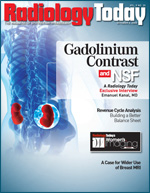
October 6, 2008
RFID Assumes a New Clinical Role
By Dan Harvey
Radiology Today
Vol. 9 No. 20 P. 9
Integrating radiofrequency identification (RFID) with a prefilled syringe and its contrast delivery system, Covidien recently introduced a new contrast injector that improves patient safety and technologist efficiency because the syringe and injector “communicate.” The system is an early example of RFID being used in a clinical application instead of the more common inventory control applications normally associated with the technology.
Covidien, formerly Tyco Healthcare, helped pioneer prefilled syringes for contrast imaging. “[Prefilled syringes] eliminated the manual filling of syringes, thus providing greater patient safety compared to multidose vial or bag methods that used the same container for multiple patients,” says Brian Straeb, vice president of U.S. marketing for imaging solutions at Covidien. “Within that system, the prefilled syringe, dosed with x-ray contrast media, is loaded directly into the power injector, and the technologist is ready to go.”
The new system, introduced in July, improves on Covidien’s unit-dose Ultraject prefilled contrast media syringes and its Optivantage DH power injector. By incorporating RFID technology, the syringe signals the injector to verify that the right product and dose are delivered to the patient. The RFID system provides the automatic capability to capture, store, and transmit data between the syringe and power injector through RFID transponders, more commonly called tags.
“Specifically, we placed an RFID tag into the label of the prefilled syringe,” explains Straeb. “Written into the tag is critical information about what a syringe contains, such as volume, concentration, manufacture date, and contrast agent brand. The tag communicates such information via an antenna imbedded within the injector.”
Air Embolism
Patients often receive separate injections of saline and contrast media before CT scanning. While that method improves the resulting images and requires less contrast, patients are vulnerable to being injected with the wrong substances or even air if empty syringes are mistakenly used. Programmed with the complete information about the syringe contents, the RFID tags block a technologist from proceeding with an injection until the injector contains the proper contrast material and dose. The injector, through the imbedded antenna and reader, also recognizes whether a syringe is empty, thereby reducing the risk of potentially lethal air embolisms. “Essentially, it places a safety belt on injection preparation. It supports the element of human intervention to help ensure nothing goes wrong,” says Straeb.
In addition, the system automatically prevents the injection of the contents from a syringe previously used during another patient exam, which reduces risk of infection from cross-contamination. The system also recognizes whether a contrast product is past its expiration date. If the RFID detects an expired syringe, it won’t inject the contrast.
Covidien’s integration provides the only RFID-enabled contrast delivery solution available in North America. Straeb says three factors allowed the company to bring the system to market. First, RFID technology has become less expensive. Second, Texas Instruments Incorporated developed an antenna technology that helped Covidien develop its new system. Finally, the antenna technology works with syringe labels produced by Canadian-based CCL+ Label for Covidien’s system.
Patient Record
For efficient record keeping, the system automatically transfers drug and exam information onto a printed label to add to the patient record. This capability reduces the need for manual data entry. “This is an important consideration, as technologists are very busy people, especially in the realm of CT, where there is a lot of pressure related to throughput,” says Straeb. “The new system not only relieves that pressure but enables the technologist to spend more time with the patient.”
The RFID-enabled integration of a syringe and a power injector helps facilities better address Joint Commission and U.S. Pharmacopoeia standards aimed at ensuring compliance with labeling and unit-dose requirements and usage of aseptic techniques. “The regulatory compliance element in radiology is an ever-growing concern,” Straeb says.
While the system is technically commercially available, Covidien initially only provided the technology to a select set of customers following the July introduction. “We did that to gain and gauge customer experience prior to a national launch, which has always been our standard approach with new equipment,” says Straeb. “So, we’ve now acquired some field experience with this product and are building upon that.” He says the company is now launching the product nationwide.
Straeb says reviews have been positive and even revealing. For instance, the company says early user feedback suggests that the system integrates into technologists’ existing workflow. “It doesn’t require them to change their work processes, and it actually eliminates some steps,” Straeb says.
— Dan Harvey is a freelance writer based in Wilmington, Del., and a frequent contributor to Radiology Today.

